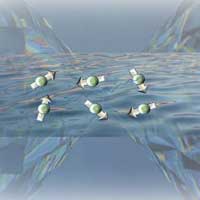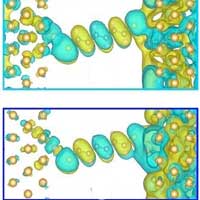 An interlayer, made of a spreadable, 'butter-like' material helps improve the current density tenfold, while also increasing performance and safety.
An interlayer, made of a spreadable, 'butter-like' material helps improve the current density tenfold, while also increasing performance and safety.
Monday, May 18, 2020
A spreadable interlayer could make solid state batteries more stable
 An interlayer, made of a spreadable, 'butter-like' material helps improve the current density tenfold, while also increasing performance and safety.
An interlayer, made of a spreadable, 'butter-like' material helps improve the current density tenfold, while also increasing performance and safety.
Scientists use pressure to make liquid magnetism breakthrough
 It sounds like a riddle: What do you get if you take two small diamonds, put a small magnetic crystal between them and squeeze them together very slowly? The answer is a magnetic liquid, which seems counterintuitive.
It sounds like a riddle: What do you get if you take two small diamonds, put a small magnetic crystal between them and squeeze them together very slowly? The answer is a magnetic liquid, which seems counterintuitive.
Pretty as a peacock: The gemstone for the next generation of smart sensors
 Scientists have taken inspiration from the biomimicry of butterfly wings and peacock feathers to develop an innovative opal-like material that could be the cornerstone of next generation smart sensors.
Scientists have taken inspiration from the biomimicry of butterfly wings and peacock feathers to develop an innovative opal-like material that could be the cornerstone of next generation smart sensors.
New wearable sensor tracks Vitamin C levels in sweat
 Researchers developed a wearable, non invasive Vitamin C sensor that could provide a new, highly personalized option for users to track their daily nutritional intake and dietary adherence.
Researchers developed a wearable, non invasive Vitamin C sensor that could provide a new, highly personalized option for users to track their daily nutritional intake and dietary adherence.
Engineers develop first tunable, chip-based 'vortex microlaser' and detector
 Encoding information in twisting beams of light could break bandwidth bottleneck in optical communications.
Encoding information in twisting beams of light could break bandwidth bottleneck in optical communications.
Quantum Hall effect 'reincarnated' in 3D topological materials
 2D order protects several entangled states that could be used in quantum computing.
2D order protects several entangled states that could be used in quantum computing.
Graphene-reinforced carbon fiber may lead to affordable, stronger car materials
 A new way of creating carbon fibers -- which are typically expensive to make -- could one day lead to using these lightweight, high-strength materials to improve safety and reduce the cost of producing cars.
A new way of creating carbon fibers -- which are typically expensive to make -- could one day lead to using these lightweight, high-strength materials to improve safety and reduce the cost of producing cars.
Scientists demonstrate the first chemically synthesized optical switch based on a MOF
 Scientists have demonstrated how to create, using a femtosecond laser, an all-optical switch based on a metal-organic framework which can be synthesized in vitro and is usually used in chemistry for gas absorption.
Scientists have demonstrated how to create, using a femtosecond laser, an all-optical switch based on a metal-organic framework which can be synthesized in vitro and is usually used in chemistry for gas absorption.
'Tantalizing' clues about why a mysterious material switches from conductor to insulator
 Tantalum disulfide is a mysterious material. According to textbook theory, it should be a conducting metal, but in the real world it acts like an insulator. Using a scanning tunneling microscope, researchers have taken a high-resolution look at the structure of the material, revealing why it demonstrates this unintuitive behavior.
Tantalum disulfide is a mysterious material. According to textbook theory, it should be a conducting metal, but in the real world it acts like an insulator. Using a scanning tunneling microscope, researchers have taken a high-resolution look at the structure of the material, revealing why it demonstrates this unintuitive behavior.
Researchers present a new route for designing a graphene-based active spintronic component
 Highly efficient charge-to-spin interconversion in graphene heterostructures.
Highly efficient charge-to-spin interconversion in graphene heterostructures.
High hopes for new-age rubber
 Imagine a self-repairing rubber, or super-adhesive made entirely from waste materials. It sounds like science fiction, but researchers have discovered a new kind of rubber and catalyst that together can be used with low energy consumption to make flexible, repairable, sustainable objects - including car tires.
Imagine a self-repairing rubber, or super-adhesive made entirely from waste materials. It sounds like science fiction, but researchers have discovered a new kind of rubber and catalyst that together can be used with low energy consumption to make flexible, repairable, sustainable objects - including car tires.
A perfect novel optical vortex with controllable impulse ring profile
 Researchers demonstrated a perfect novel optical vortex with controllable impulse ring profile based on Circular Dammann Gratings.
Researchers demonstrated a perfect novel optical vortex with controllable impulse ring profile based on Circular Dammann Gratings.
Riddled with holes: Making flexible thin-film electronics more durable
 Researchers developed a simple approach for controlling the otherwise random formation of cracks in flexible thin-film conductors, greatly increasing the durability of flexible electrodes and transistors against bending and folding.
Researchers developed a simple approach for controlling the otherwise random formation of cracks in flexible thin-film conductors, greatly increasing the durability of flexible electrodes and transistors against bending and folding.
A theoretical boost to nanoscale devices
 Scientists have developed a new approach to the underlying physics of semiconductors to engineer nano-scale transistors hit the limits of miniaturization at the atomic level.
Scientists have developed a new approach to the underlying physics of semiconductors to engineer nano-scale transistors hit the limits of miniaturization at the atomic level.
Subscribe to:
Comments (Atom)
